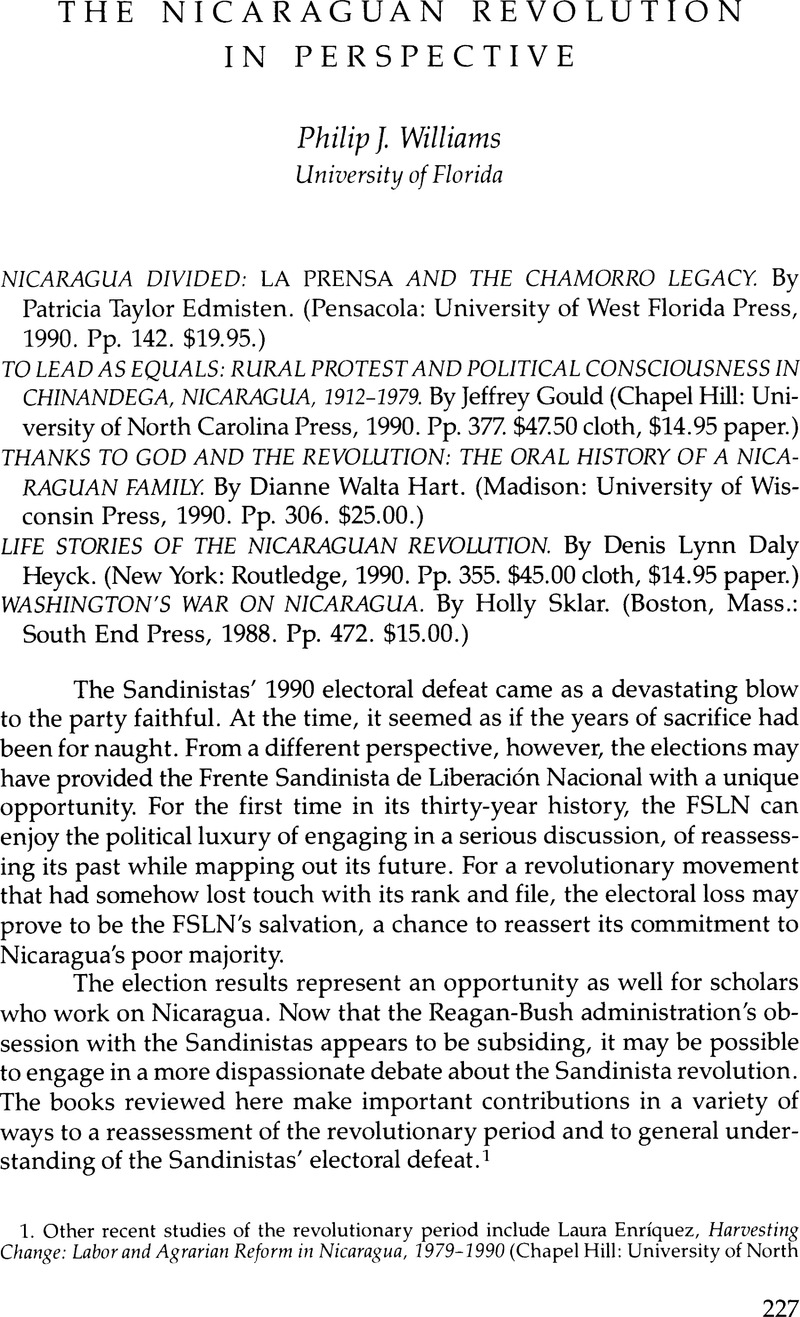No CrossRef data available.
Published online by Cambridge University Press: 12 October 2022

1. Other recent studies of the revolutionary period include Laura Enríquez, Harvesting Change: Labor and Agrarian Reform in Nicaragua, 1979–1990 (Chapel Hill: University of North Carolina Press, 1991); Michael Dodson and Laura Nuzzi O'Shaughnessy, Nicaragua's Other Revolution: Religious Faith and Political Struggle (Chapel Hill: University of North Carolina Press, 1990); and Dennis Gilbert, Sandinistas: The Party and the Revolution (Cambridge: Basil Blackwell, 1988). See also Kenneth Mijeski's recent review essay, “From Solidarity to Class Struggle: Ten Years of Post-Somozan Nicaragua,” LARR 26, no. 2 (1991):247–60.
2. Donald Hodges's in-depth study of Sandino's political thought argues that Sandino's political ideology can be characterized as “anarcho-communism,” which synthesizes elements from a number of sources, including anarcho-syndicalism, socialism, communism, and spiritism. See Donald Hodges, Intellectual Foundations of the Nicaraguan Revolution (Austin: University of Texas Press, 1986).
3. Oscar René Vargas, Adonde va Nicaragua: perspectivas de una revolutión latinoamericana (Managua: Ediciones Nicarao, 1991), 70–84.
4. For more on the women's movement in Nicaragua, see Maxine Molyneaux, “Mobilization without Emancipation? Women's Interests, the State and Revolution in Nicaragua,” Feminist Studies 11, no. 2 (1985).
5. Quoted in René Mendoza, “We Erred to Win,” Envío, no. 111 (Oct. 1990):24.
6. Sklar's and Arnson's books complement each other and ideally should be read together. See Cynthia Arnson, Crossroads: Congress, the Reagan Administration, and Central America (New York: Pantheon, 1989).
7. For a discussion of the ideological right's role in Reagan administration policy toward Central America, see Laurence Whitehead, “Explaining Washington's Central American Policies,” Journal of Latin American Studies 15, pt. 2 (Nov. 1983):321–63.
8. Gould's conclusions corroborate the findings of other scholars who have emphasized the importance of religious faith in the growing political radicalization of poor Nicaraguans. See Philip Williams, The Catholic Church and Politics in Nicaragua and Costa Rica (Pittsburgh, Pa.: University of Pittsburgh Press, 1989); and Dodson and O'Shaughnessy, Nicaragua's Other Revolution.
9. See Carol Smith, “Culture and Community: The Language of Class in Guatemala,” in The Year Left: An American Socialist Yearbook, edited by Mike Davis (London: Verso, 1987).
10. See Lowell Gudmundson, Costa Rica before Coffee (Baton Rouge: Louisiana State University Press, 1986); and William Roseberry, Coffee and Capitalism in the Venezuelan Andes (Austin: University of Texas Press, 1983).
11. In the wake of their electoral setback, Sandinista leaders are much more willing to discuss openly the party's relationship with popular organizations. For studies conducted prior to the 1990 elections, see Gary Ruchwarger, People in Power: Forging a Grassroots Democracy in Nicaragua (South Hadley, Mass.: Bergin and Garvey, 1987); and Ilja Luciak, “Popular Democracy in the New Nicaragua,” Comparative Politics 19, no. 4 (Oct. 1987):35–55.
12. This situation was no doubt compounded by the party's internal crisis immediately following the elections.